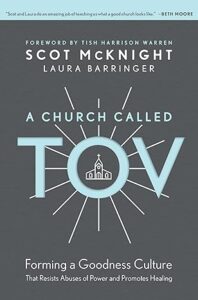Church Abuse: Protecting Ministries, Destroying Souls
Dr. Diane Langberg, author of Redeeming Power
Speak Life
Dr. Diane Langberg, author of Redeeming Power
How do we respond rightly to abuse and make the church of Christ a place of healing and hope, rather than a cover for predators? Glen Scrivener recorded this interview with Diane Langberg in the wake of the Ravi Zacharias scandal and within days of the Jonathan Fletcher scandal breaking. Christians were stunned and confused and asking why.
The Rise and Fall of Mars Hill
Christianity Today
This series of podcasts chronicles what happened to Mars Hill under the leadership of Mark Driscoll.
It reveals many of the steps that erode a church under the leadership of a dangerous spiritual leader and how that influences the behavior other leaders as well as congregants.
Do you recognize any behaviors or patterns?
An interview with Michael Kruger, author of Bully Pulpit
Guilt, Grace, Gratitude
Bully Pulpit is written from a Reformed perspective “from a church leader to church leaders.” Michael Kruger brings his unique perspective as a Biblical scholar to the issue of spiritual abuse– a phenomenon as old as the Bible. Currently, abuse has often been associated with celebrity pastors; however, what makes a pastor a “celebrity” pastor is not the size of his church, but the congregation’s view of the pastor and his view of himself.
Quote
One of the hallmark indicators [of abusive leaders] is … a debris field of broken relationships… a trail of dead bodies that goes back years and years and years…destroyed lives…people who are estranged from this person… That is red flag #1.
Wade Mullen on How to Spot Spiritual Abuse
Julie Roys: Restore Chicago Conference
Jeremiah 5: 26-28 describes men whose “houses are full of deceit” and who “set traps” to ensnare other human beings to benefit themselves. They are utterly unconcerned for others.
Utilizing his doctoral research on how over 500 evangelical churches “managed people’s impressions in the wake of an image-threatening event,” he describes the patterns of strategies most frequently used to deceive and ensnare.
Mullen enables us to identify potential warning signs of abuse, but his specific hope is that understanding these patterns will be especially helpful to those who have suffered abuse in churches because “an important step to recovery is acquiring the ability to make sense of what happened to you.”
Dean Ortland Whistleblower Speaks Out on Workplace Bullying: Part 1
Julie Roys Podcast
Dean Ortland Whistleblower Speaks Out on Workplace Bullying
Interview with Emily Hyland, whistleblower, who realized something was wrong, reported it to two elders, and was terminated within days and with Paul Coughlin, founder of The Protectors : Freedom from Bullying , an organization to combat bullying in schools & other organizations and to build “courage, character, and leadership for life” He is the author of Raising Bully-Proof Kids, Five Secrets Great Dads Know, and No More Christian Nice Guy. Their impressive bios are included on the the Roys Report website.
The podcast is accompanied by a transcript that has time stamps, enabling you to read while you listen, or to read first and then listen to the portions which most interest you.
Scott McKnight on Warning Signs of a Toxic Church Culture
Smallgroups.com
This segment of a longer interview with Scott McKnight is only 4 ½ min. long but is packed with content. Whether you are evaluating a potential new church or sense something is not right in your current church, this succinct list of signs will alert you to raise your level of scrutiny. Jesus commands us all to “Beware,” and this practical list will help you do that. His five signs:
A leader lacks empathy
People are afraid to bring up a concern
People are afraid of being humiliated or insulted
You sense that the reputation of the group or organization is more important than the person
You realize that stories are getting told with some “spin” that makes the leader or organization look better than reality
Dean Ortland Whistleblower Speaks Out on Workplace Bullying: Part 2
Julie Roys Podcast
Dean Ortland Whistleblower Speaks Out on Workplace Bullying Part 2
Continuation of interview with Emily Hyland, whistleblower, and Paul Coughlin, founder of an anti-bullying organization to combat bullying in schools & other organizations and to build “courage, character, and leadership for life” The Protectors: Freedom from Bullying. He is the author of Raising Bully-Proof Kids, Five Secrets Great Dads Know, and No More Christian Nice Guy. Their impressive bios are included on the the Roys website.
This podcast is accompanied by a transcript that includes timestamps.
Content
This segment covers the news in Emily’s ongoing case. Her case was heard by the Illinois Department of Human Rights, and elevated to the Human Rights Commission. A finding that her report of bullying was met with retaliation was substantiated. Additionally, there is an upcoming trial for unpaid wages involving the Illinois Department of Labor.
Those of you who witnessed the recent history at Chapel Hill Bible Church, heard the personal stories of some staff members, and read newspaper accounts might also recognize several patterns in this situation. Recognition of patterns is critical to clearly discerning truth.
Hope and Disillusionment: Recovery from the Ravi Zacharias Scandal
Most first-person accounts of survivors of spiritual abuse come from people who experienced direct abuse from a key leader in a Christian organization, such as the women who testified to experiencing sexual and spiritual abuse by Ravi Zacharias. Carson Weitnauer’s story of spiritual abuse had different roots.
His testimony is that of a loyal insider at Ravi Zacharias International Ministries (RZIM). He had been a devoted follower of Ravi Zacharias from the time he had a personal conversation with him as a teenager. Carson had known only good from Ravi, who influenced his Christian journey in very positive ways. He was thrilled when offered the opportunity to serve on the staff of RZIM ministries, where he served for 7 years. He describes his work at the Christian ministry as core to his sense of identity; it was his community, gave him his sense of purpose, and was where his faith and spirituality thrived.
However, after Ravi’s death, allegations from several women that Ravi had abused them became public. Carson began to read news stories, ask questions, seek the truth, and eventually to advocate for the women. He consequently experienced what he describes as “lies, bullying, and spiritual abuse” from others in the RZIM organization.
The first portion of the presentation is about the process of wrestling with cognitive dissonance as he sought to determine what was true, and then about being disillusioned twice: first by Ravi, as Carson came to understand that Ravi was an abuser, and then again by RZIM– the ministry where Carson had served and whose integrity he had trusted . As he says in the presentation: “In September 2020, I lost my confidence in Ravi. By December 2020, I lost my confidence in RZIM. And in January of 2021, I resigned.”
The second portion of his presentation is what life was like after he choose to believe the truth and it cost him what seemed like everything.
Throughout, Carson allows the viewer a poignantly honest view into his thinking, the intensity of his emotions, and the impact on his spiritual life.
The patterns of behavior Carson experienced at RZIM are predictable– whether the precipitating issue threatening the image of an organization involves allegations of sexual abuse or other types of allegations. At Chapel Hill Bible Church, for instance, there were no allegations of sexual abuse.
For those who have been through a similar process: moving through initial cognitive dissonance, the pain of the truth, and then embarking on a journey of recovery, whether at Chapel Hill Bible Church or elsewhere, this presentation may in many ways give voice to your own story and offer some useful help on your journey to recovery.
For those who are congregants at Chapel Hill Bible Church or bystanders elsewhere and wonder why certain elders, staff, and congregants left or why they felt compelled to speak out, this may help you understand.
TEMPLATE
Julie Roys Podcast
Dean Ortland Whistleblower Speaks Out on Workplace Bullying Part 2
Continuation of interview with Emily Hyland, whistleblower, and Paul Coughlin, founder of an anti-bullying organization to combat bullying in schools & other organizations and to build “courage, character, and leadership for life” The Protectors: Freedom from Bullying. He is the author of Raising Bully-Proof Kids, Five Secrets Great Dads Know, and No More Christian Nice Guy. Their impressive bios are included on the the Roys website.
This podcast is accompanied by a transcript that includes timestamps.
Content
This segment covers the news in Emily’s ongoing case. Her case was heard by the Illinois Department of Human Rights, and elevated to the Human Rights Commission. A finding that her report of bullying was met with retaliation was substantiated. Additionally, there is an upcoming trial for unpaid wages involving the Illinois Department of Labor.
Those of you who witnessed the recent history at Chapel Hill Bible Church, heard the personal stories of some staff members, and read newspaper accounts might also recognize several patterns in this situation. Recognition of patterns is critical to clearly discerning truth.
TEMPLATE
Smallgroups.com

Bully Pulpit:
Confronting the Problem of Spiritual Abuse in the Church
By Michael J. Kruger
Is “spiritual abuse” real or a modern form of victim mentality?
Michael J. Kruger answers this question with the scholarly biblical precision that you would expect from the president of Reformed Theological Seminary in Charlotte, NC, where he is also a professor of New Testament and Early Christianity. His scholarly focus has been on the New Testament Canon.
TGC Award-winner
Bully Pulpit will be particularly helpful to people who are trying to understand spiritual abuse and who identify strongly with the theological perspective of The Gospel Coalition. It was chosen by TGC as the 2022 Book of the Year under the category of Ministry.
 Photo Credit ESA/Hubble Creative Commons Attribution 4.0
Photo Credit ESA/Hubble Creative Commons Attribution 4.0Stars in Our Garden:
Finding Hope When You’ve Been De-Hoped
By Wade Mullen
This essay offers a beautiful metaphor of hope for those who have been targets of abuse. Beyond that, it offers a vision for how others can become “stars in their garden,” bringing light and hope.
Quotes:
“…the vast majority [of people who have been abused] still carry untold, disbelieved, or ignored stories, slowly becoming (if not already) de-hoped. They hope to find a source of light, but have only been met with more darkness: betrayals that re-victimize, further silence, and de-hope.”
“So, whenever we are in a position to help and we choose to listen, affirm, and act justly, we help another become re-hoped. We open the possibility for there to be some way forward. We become a source of light…”
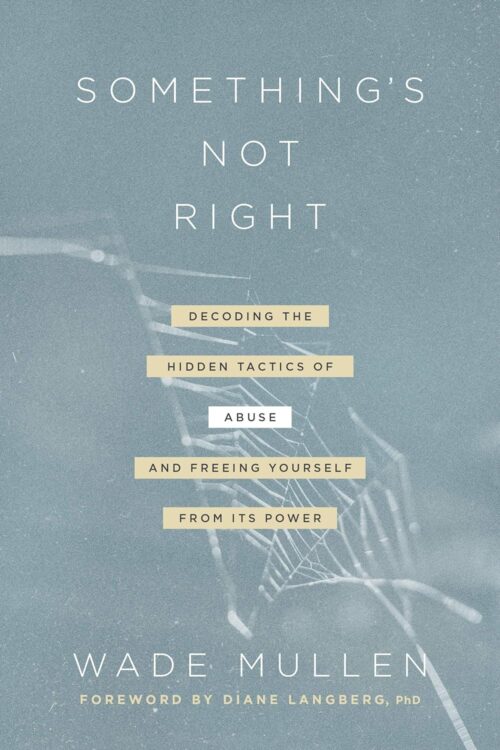
Something’s Not Right: Decoding the Hidden Tactics of Abuse and Freeing Yourself from its Power
By Wade Mullen
Forward by Diane Langberg
What do you get from an author who has done extensive research analyzing the patterns of over 1000 instances of church responses to abuse, who himself experienced abuse in a church when he attempted to advocate for others, and who has a wise and compassionate shepherd’s heart? Wade Mullen’s Something’s Not Right: Decoding the Hidden Tactics of Abuse and Freeing Yourself from its Power. It’s a powerful book.
“There is a pattern that accompanies abuse, as if abusers are reading from the same playbook.“
Understanding the playbook and decoding that pattern is critical for the people for whom this book was written:
- Those who sense that something’s not right in their church, but aren’t sure what exactly is wrong
- Those who recognize they are being abused but are confused and need wisdom about how to resist the abuse and heal
- Advocates who have put themselves between an abuser and their target
- Those who have become the enablers of an abuser, whether by conscious choice or by being groomed and deceived
Mullen speaks to the mind, using a high level of specificity gleaned from his research to help us to understand and recognize patterns and to discern what is going on. He describes the specific patterns of behavior used to both draw in victims and create allies for the abuser, the patterns used to dismantle victim’s internal and external worlds, and the patterns of impression management that will be used if the abuse comes to light. Ignorance of these patterns makes a community an easy mark for deception. The ability to recognize these patterns can enable a community to resist abuse.
But Wade Mullen goes well beyond imparting critical knowledge. He provides balm to wounded hearts both by his personal understanding of what the experience is like and by naming patterns that give you a path out of confusion and let you know that you are not alone. And he offers hope by giving practical steps that you can take to further your own healing or that of your community.
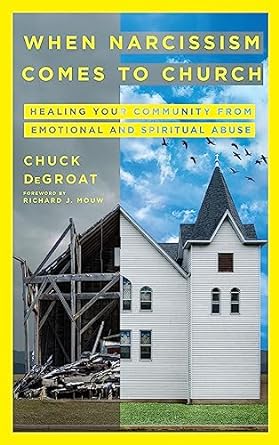
When Narcissism Comes to Church: Healing Your Community from Emotional and Spiritual Abuse
By Chuck DeGroat
What is narcissism? We hear that label applied frequently, but is it even valid? How prevalent are the patterns of behavior of narcissism among church leaders? What do churches need to know about narcissism and its impact? What can they do to prevent its destructive effects? When narcissism has reared its head among the leaders themselves, what can leaders do to guide a church to healing?
Chuck DeGroat’s When Narcissism Comes to Church answers these questions. It contains clear descriptions of narcissistic behavior patterns and includes stories as illustrations to further understanding. DeGroat goes beyond describing the individual to describe the impact of the “yeast” of a narcissistic leader on the whole church, from the leadership to the congregants. (“A little yeast works through the whole batch of dough.” NIV Gal. 5:9)
People who have experienced spiritually and emotionally abusive treatment by narcissistic pastors are likely to have some “Aha!” moments as they see the strategies employed to harm them given names, validating their experience.
Chuck DeGroat maintains a humble, compassionate, and nuanced perspective on narcissism. He affirms both the validity of the diagnosis and its devastating impact on victims. Yet, quoting Elinor Greenberg, he writes: “When we diagnose, we are describing a pattern…never a person. All people are unique. Labels, however well intended, cannot do justice to human complexity.” (p.10) In addition to recognizing that the diagnosis does not equal the person, DeGroat recognizes that the patterns of narcissism come in “many faces” and describes several.
DeGroat writes from broad and deep experience. He has served as pastor, and is now a licensed therapist, professor at Western Theological Seminary, and director of a counseling center there. He has over 20 years’ experience working with both people with narcissism and people wounded by them.
“So, whenever we are in a position to help and we choose to listen, affirm, and act justly, we help another become re-hoped. We open the possibility for there to be some way forward. We become a source of light…”
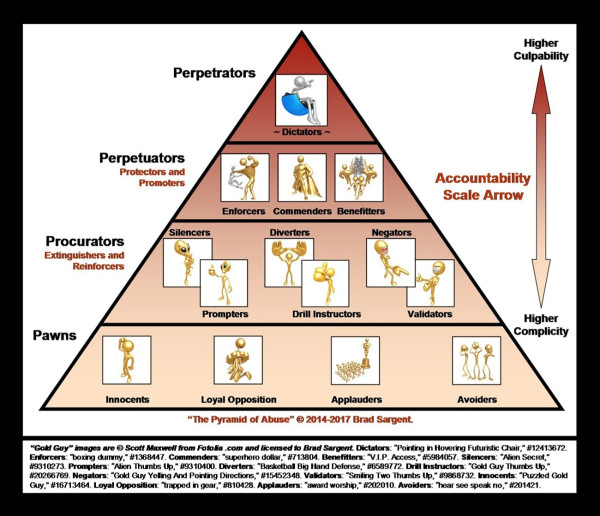
The Pyramid of Abuse and Scale of Accountability (c) 2018 Brad Sargent aka “futuristguy”
Image used by permission.
The Pyramid of Abuse
Brad Sargent
It was 2014. Mars Hill was imploding and evangelical Christians were shocked and trying to understand why and how such dysfunction could have developed in what seemed to be a thriving multi-campus church that people had been encouraged to emulate.
Brad Sargent had been pondering such questions for years as a result of his own experiences. In 2014, he developed the diagram, The Pyramid of Abuse, to convey how abuse thrives in a church or Christian organization. Many people have found it helpful to their understanding both of what was happening at Mars Hill and also as a useful way of understanding their own experiences in other churches or Christian organizations. It’s also very applicable to other systems such as businesses and political parties . It’s been repeatedly shared online.
Before reading further, look over the pyramid. Without getting too concerned about what each role means, what is the big idea you get from this image? What other insights spring to mind?
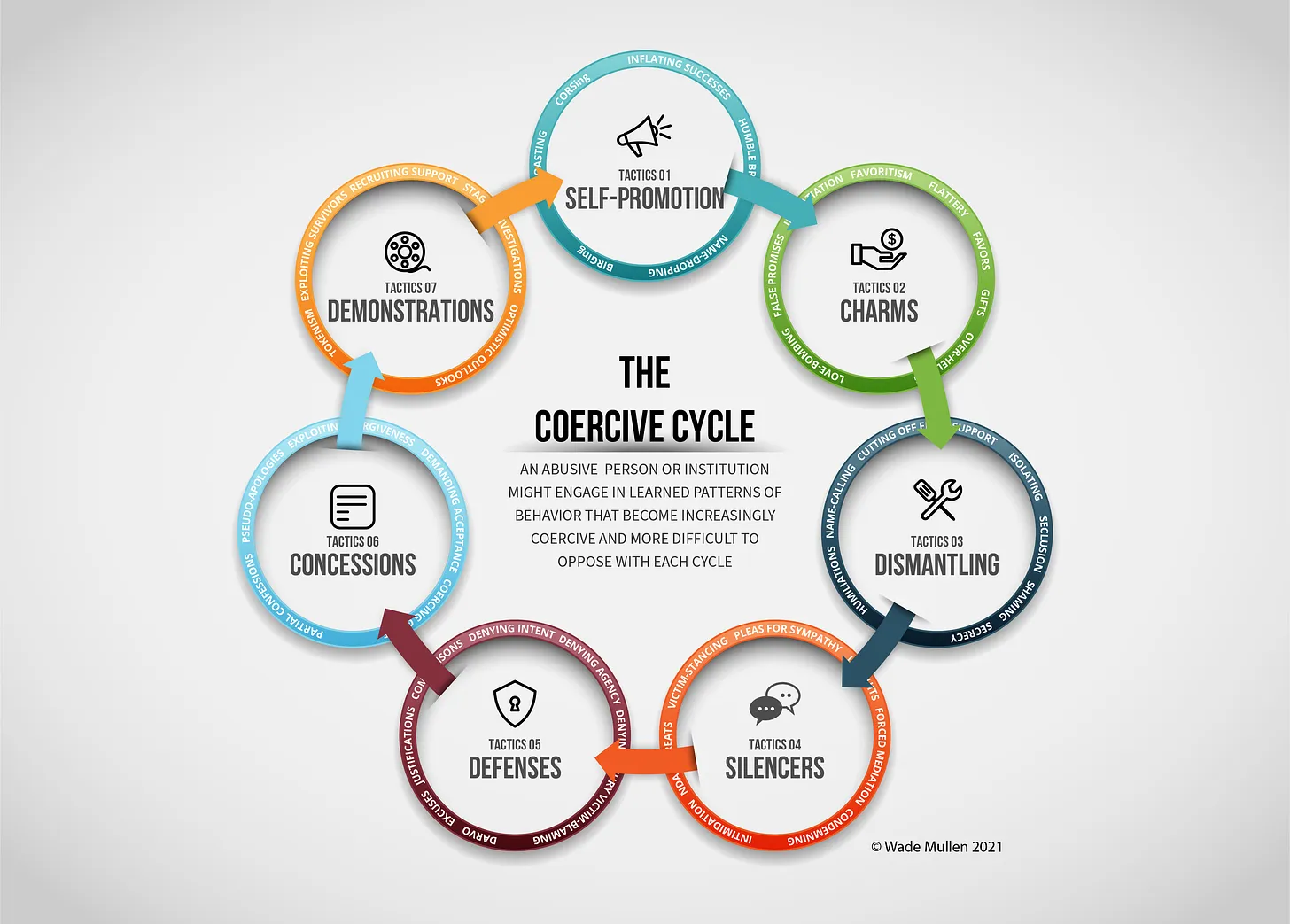
The Coercive Cycle by Wade Mullen. Used by permission.
The Coercive Cycle
Wade Mullen
Study the diagram. The large words inside each circle name a set of tactics. The white words written on the colored rings name the specific tactics. Have you observed or personally experienced any of these in a church or Christian organization? (Note: use of various tactics may not come in order. They may vary per situation. It’s the pattern of of use that should grab our attention.)
A Church Called Tov: Forming a Goodness Culture
by Scot McKnight and Laura Barringer
Laura Barringer and her husband were in shock as they read the news report The Chicago Tribune: their long-time pastor, Mark Hybels, whom they greatly respected, had been accused of sexual misconduct. Their first reaction was disbelief, but then they read the names of the women who were alleging it. Because these were women they also respected, they were thrown into a profound state of cognitive dissonance as previously held beliefs about the character of the accused and his accusers collided. They couldn’t both be true.
Laura called her father, Scott McKnight, a professor of New Testament, to get his perspective. He said he thought the allegations were likely true. “How do you know?” she asked. His answer was both that it was highly unlikely that all the witnesses were making up a story and that the pattern of the church’s response of denial and planting seeds of doubt about the accusers was a highly predictable one, seen frequently when scandals arise regarding a church leader.
Have you ever been in this situation, when a pastor whose sermons you’ve appreciated and whose leadership you’ve respected, has been credibly accused of misconduct? If so, or if you’d like to be proactive and be part of a church culture that cultivates the kind of tov that makes this unlikely, this book is for you.
What is tov? It’s the Hebrew word for goodness. “And God saw all that he had made and it was very tov.” Gen “You are Tov and do Tov.” Ps 119: 68 “Oh, taste and see that the Lord is Tov!” Ps. 34:8
Their experience at their church motivated them to do something constructive: to paint a vision —both theological and practical— of kind of church culture that is resistant to abuse of power, and instead is a place of tov.
Their vision of a “Circle of Tov” is a church with a culture that intentionally nurtures empathy, grace, putting people first, truth, justice, service, and Christlikeness.

TEMPLATE.
The Coercive Cycle
Wade Mullen
Study the diagram. The large words inside each circle name a set of tactics. The white words written on the colored rings name the specific tactics. Have you observed or personally experienced any of these in a church or Christian organization? (Note: use of various tactics may not come in order. They may vary per situation. It’s the pattern of of use that should grab our attention.)

